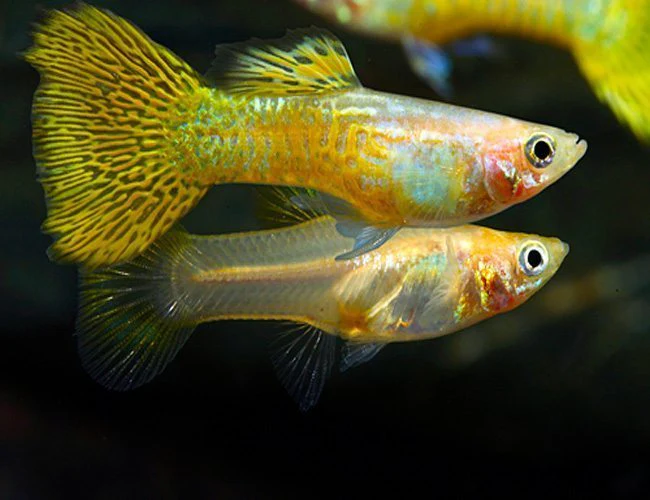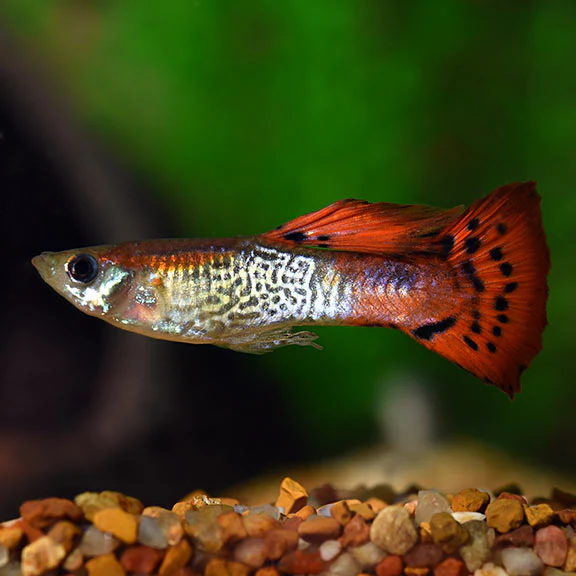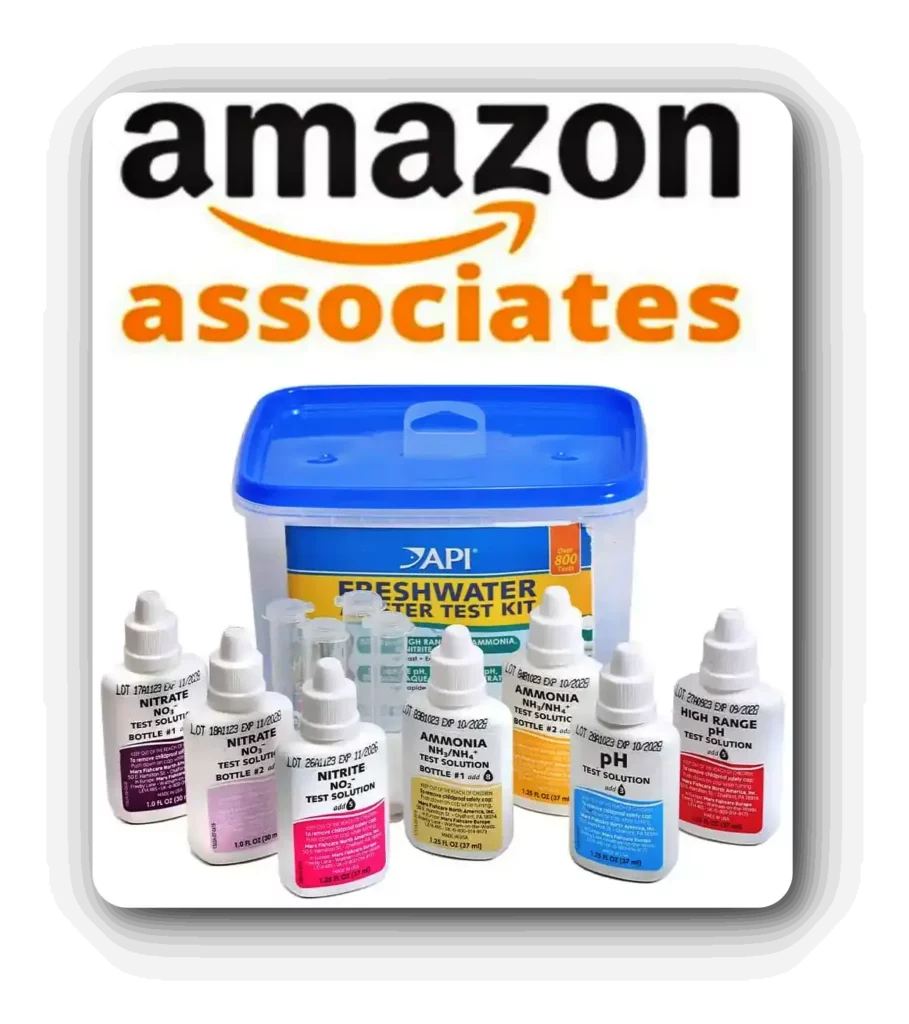Premium health care, environmental setup, and nutrition tips for keeping a healthy Cobra Guppy in a community tank.

Unraveling the Beauty of the Cobra Guppy
This snake-patterned guppy is one of the most beautiful fancy variants for home aquariums. This vibrant freshwater fish stands out for its unique scale patterns, colors, and physical characteristics.
Ornamental guppy varieties have quickly become one of the most popular additions for aqua enthusiasts because, despite their fancy appearance, they often require low maintenance.
If you’re ready to give this popular aquarium fish a chance to beautify your tank, read this complete care guide.
I analyze the intricacies of the Snake-patterned guppy’s beauty and the best care methods for preserving it. Let’s start from the beginning.
Origins and Selective Breeding of Cobra Guppies
Understanding Cobra Guppy’s origins helps you know its core needs for survival. Like many late 20th-century species from the Northeastern regions of South America, selective guppy breeding birthed the Cobra variant.
That’s why it still has the fin and body structure of the common guppy while coming out with unique coloration. Fish traders sought to create new colors and fin structures by controlling the natural breeding patterns in guppies.
They isolated preferred genetic traits and discovered the distinctive cobra pattern hobbyists have come to love. Let’s take a closer look at these physical traits and how to identify the Cobra Guppy.
Distinctive Physical Traits of Cobra Guppies

The snake-patterned guppy’s body is the standout feature of this small ornamental fish.
The Coloration and Pattern
Its scales have an elaborate burst of colors ranging from red to orange, yellow, blue, and green. These striking, guppy colors often come in a mixed tone rather than a single solid color similar to a snake’s skin.

The Body Structure
Like the common guppy, the Cobra species has a small body that stretches between 1.5 and 1 inches while its tail fin extends to almost the same length. So, the total size of a mature Cobra guppy, including its fins, is 2.5 – 3 inches.
The Fins

Common guppies often have a variation of tail structures, from dramatic fan-like fins to modest lyre or swordlike structures. Of all these unique guppy tail shapes, the fan and dumbo ear fin structure is the most common for Cobra guppies.
Considering these unique physical traits, you can now understand why the Cobra guppy requires specialized care for survival.
Care Essentials for Cobra Guppies
Basic Cobra Guppy care tips include:
- Performing regular water changes
- Monitoring the water parameters
- Feeding your pets a balanced and nutritious diet and
- Preserving their mental health by keeping them with ideal tank mates.
These tips work together for the good of your Cobra guppy such that the absence of one may lead to death. If you’re interested in maintaining guppy health and don’t mind, here are some care guidelines for you —
Ideal Water Parameters
Cobra guppies are freshwater fish, so they need warmth to survive in the aquarium. Set the water temperature to 72-78℉ with a pH level of 6.8 – 7.8 for slight alkalinity and a hardness of 10 – 20 dGH.
Although this species doesn’t mind periodic variations in water parameters, I recommend stability.
We recommend using a master test kit like the one form amazon linked below to frequently test your water parameters.
Maintaining Water Quality
You can maintain the water quality by performing regular water changes of 20 – 30%. Add an efficient filtration system to help clean the water after feeding. It will speed up the nitrogen cycle and convert leftover food with Ammonia into nitrate and nitrite.
Regulate the filtration current to mild or slow to avoid sucking your Cobra guppies into the canister during activity. It’s best to get a sponge filter that absorbs debris and dirt without harming your pets.
Setting Up the Ideal Habitat for Cobra Guppies
When building your aquarium, you must ensure it has a guppy-friendly tank setup. What does this mean? Your tank should accommodate your Cobra guppy’s physical traits without compromise.
Tank Size
Get a horizontal tank that holds up to 10 gallons of water per single fish or mini group. You can then increase the size as your school becomes larger. Note that large tanks allow your pets to swim comfortably while maintaining water stability.
It’s also easier to regulate the filtration system in a sizable tank than in a mini design.
Tank Decor

When selecting aquarium decor, look at the natural habitat that birthed your Cobra Guppy. Then, mimic its features with decorative pieces like driftwood, fern, small rocks, smooth pebbles, and granite.
Add live or artificial plants to beautify the tank and give your Cobra guppy several good hiding spots. You can place your plants strategically over your aquarium lighting.
For more on choosing aquarium plants check out our article on Easy Aquarium Plants For Beginners!
Feeding and Nutrition for Cobra Guppies
Lucky for beginners in Cobra Guppy diet preparation, these pets feed on a diet containing all the food classes. They eat micro-pellets or flakes as their staple and then supplement them with live or frozen food.
For more on feeding your aquatic pets check out The Ultimate Guide to Fish Food: Pros and Cons & Best Choices!
Feeding Frequency
Cobra guppies can eat a lot, but you shouldn’t encourage overfeeding. Give your pets only portions they can consume between 1 – 3 minutes, but you can feed them nutritious food two to three times daily.
I recommend creating a routine to help your pets eat enough for their health without complicating it. Using a guppy feeding routine for your Cobra species gives them a sense of familiarity and calms their nerves.
But there’s only so much prevention you can rely on through your guppy feeding best practices. Sometimes, your pets may be prone to an illness based on genetics or simple mistakes. When that happens, here’s what to do!
Health Concerns and Disease Prevention
Poor water quality, poor diets, and genetic predispositions can complicate your Cobra Guppy’s health. Preventing diseases is easy if you follow the guidelines I’ve shared with you so far. But where your Cobra guppy falls sick regardless, here are some common guppy health problems they may face and how to tackle them:
White Spot
Symptoms: White spots on the fish’s skin like grainy salt, Scratching, Rapid Gill Movement, Loss of Appetite, and Laziness.
Cause: Poor water quality
Treatment: Increase water temperature to 80 – 85℉, use anti-itch meds, and change the water.
Fin Rot
Symptoms: Damaged fins, discoloration, fraying edges, loss of fin tissue, and ragged appearance.
Cause: Fungal infections, Bacteria, and Poor water quality
Treatment: Change water, use antibiotics, or antifungal treatment.
Velvet Disease
Symptoms: Dusty skin, increased gill movement, and labored breathing
Cause: Oodinium parasite
Treatment: Copper-based treatment, antiparasitic meds, and improved water quality.
Dropsy
Symptoms: Swollen body, laziness, abdominal swelling
Cause: Internal infection or poor water quality
Treatment: Antibiotics, change the water, improve the water quality, and use aquarium salt solution.
Skin Fluke
Symptoms: Pinkish spots on fins, loss of appetite, laziness, Rubbing against objects and excessive scratching
Cause: Parasites
Treatment: Improve water quality.
More prevention tips for your Cobra guppy include:
- Monitor your pet’s behaviors and act immediately if there’s a change in typical patterns.
- Quarantining new fish before adding them to the main tank. So that if they have a contagious disease, it won’t spread.
- Don’t overcrowd your Cobra guppy and send them into a permanent stage of stress.
- Always clean your tank for leftover food to prevent ammonia poisoning.
Breeding Cobra Guppies: Key Tips
If you love this species so far and can’t wait to start breeding Cobra Guppies, this part is for you.
Selecting the Breeding Pair
Separate the male and female Cobra guppies if you’re not ready to co-parent. Always make the ratio of female to male Cobra Guppies 2:3 to avoid aggression and territoriality. When selecting guppy breeding pairs, it’s always best to watch for natural duos.
This video has been very helpful in identifying the sex of Guppies, I highly recommend it:
The Breeding Environment
The Cobra guppy breeding conditions are similar to the water parameters for keeping a common guppy. Add more greenery and caves to the breeding tank to ensure the female Cobra guppy has enough privacy when spawning.
Spawning
Your female Cobra guppy gets a dark spot around her head when she’s pregnant. Feed your female guppies with fertility-enhancing foods like spirulina and algae wafers. So, as they skip the eggs to the larvae stage, you must watch out for your Cobra guppy fry.
As they become older, add the Cobra Guppy to your main tank, but first, separate weaker ones from their stronger counterparts.
The Fry
You may feed your free-swimming livebearers with infusoria, then graduate to finely crushed flakes and smooth pebbles. Get a grow-out tank to move the smaller pets from the larger ones to prevent predation.
Cobra guppies live peacefully with other livebearers, Tetras, and Shrimps because they have a calm personality. But stress and discomfort can trigger parts of this species that put you off owning an aquarium.
If you want a peaceful aquarium setup, conduct a compatibility test before adding any new fish or water-dwelling species to your tank.
You must first consider the Cobra Guppy’s social behavior and how they interact with others, then consider its physical characteristics.
For its social behavior, Cobra guppies are active swimmers who enjoy moving in groups. You can have a maximum of 6 different species in one 10-gallon tank.
There are three tests for community tank compatibility – environmental needs, physical traits, and temperament. Only pair species that can survive in the same water parameters live together without getting territorial or harming themselves.
Other tips for managing guppy interactions include:
- Pairing fish with matching physical features
- Separating aggressive species from calmer ones
- Noting fish that stress your Cobra guppies and removing them from the tank.
Conclusion
That’s all I have for you on today’s Cobra Guppy care overview. I hope you’ve enjoyed reading about these snakeskin species and are ready to add the ornamental guppy beauty to your aquatic world.
You can start small with a single Cobra guppy in your ten-gallon tank, then build your way into a larger aquarium. Remember to pay attention to this species’ physical and mental needs, as you can’t sacrifice one for the other.
Aquarium care mastery starts with little steps, and you’ll be well on your way after following this care guide.



